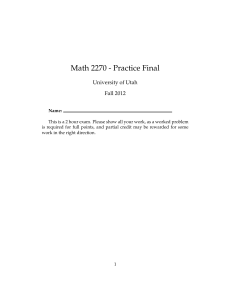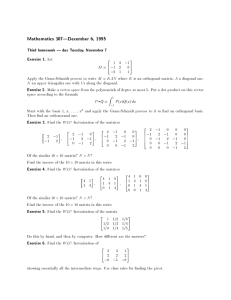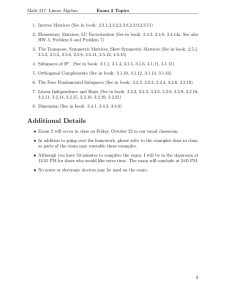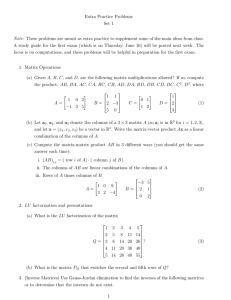Numerical Methods I: Numerical linear algebra Georg Stadler, Jonathan Goodman
advertisement
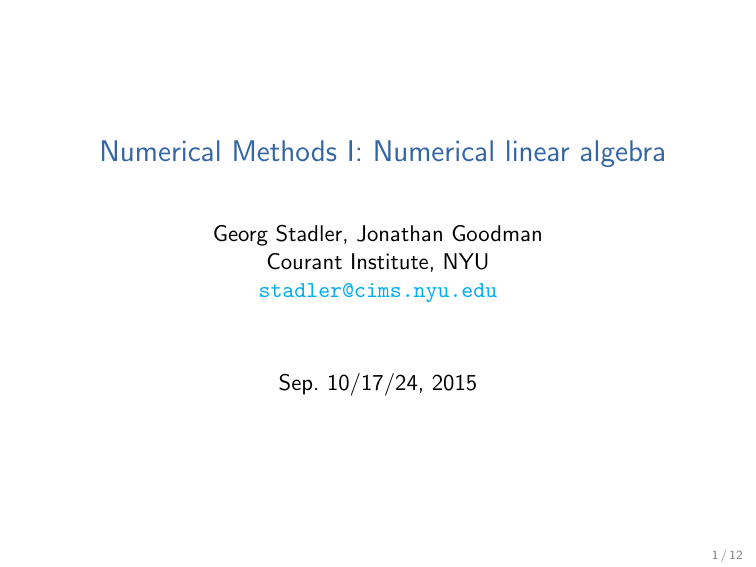
Numerical Methods I: Numerical linear algebra Georg Stadler, Jonathan Goodman Courant Institute, NYU stadler@cims.nyu.edu Sep. 10/17/24, 2015 1 / 12 Sources/reading I assume familiarity with basic linear algebra (vectors, matrices, norms, matrix norms). See Section 1 of Quarteroni/Sacci/Saleri. Main reference: Section 3 in Quarteroni/Sacci/Saleri and Section 1 in Deuflhard/Hohmann 2 / 12 Solving linear systems We study the solution of linear systems of the form Ax = b with A ∈ Rn×n , x, b ∈ Rn . We assume that this system has a unique solution, i.e., A is invertible. Solving linear systems is needed in many applications. Often, we have to solve I large systems (can be up to millions of unknowns, and more) I as fast as possible, and I accurately and reliably. There exist explicit formulas for solving linear systems but they are extremely expensive (e.g., Kramer’s rule requires computing determinants). 3 / 12 Kinds of linear systems Solvers take advantage of special properties of the matrix. sparse/dense matrix I Dense: the best way to compute Ax is direct summation I Fast algorithms for computing Ax, FFT, FMM, ... I Most aij = 0: store only non-zeros, avoid fill in. I Structured/unstructured: is the sparsity pattern easy to describe without storing it explicitly? Symmetry, etc. I Special factorizations for symmetric or skew symmetric matrices I Special factorizations for positive definite matrices. I Diagonally dominant matrices don’t need pivoting. 4 / 12 Solving linear systems Triangular systems: Forward and backward substitution, requires n(n + 1) multiplications/divisions, 2 n(n − 1) additions. 2 Overall: ∼ n2 floating point operations (flops). We count flops to estimate the computational time/effort. Besides floating point operations, computer memory access has a significant influence on the efficiency of numerical methods (see experiments in homework #2). 5 / 12 Solving linear systems Gaussian elimination—LU factorization a11 .. . ··· an1 · · · a1n x1 b1 .. .. = .. . . . ann Gaussian elimination: “new row = a11 · · · · · · · · · 0 a0 22 · · · · · · .. .. . . .. .. . . 0 a0n2 · · · · · · New system matrix/rhs is: A(2) = xn bn row i - li1 row 1” a1n x1 b1 0 a2n x2 b02 .. .. . = b03 . .. .. .. . . . 0 b0n ann xn L1 A, b(2) = L1 b. 6 / 12 Solving linear systems Gaussian elimination—LU factorization a11 .. . ··· an1 · · · a1n x1 b1 .. .. = .. . . . ann Gaussian elimination: “new row = a11 · · · · · · · · · 0 a0 ··· 22 · · · .. 00 . 0 a33 · · · .. .. . . 0 0 a00n3 · · · xn bn row i - li1 row 1” a1n x1 b1 0 0 a2n x2 b2 . . b003 a003n . = .. .. .. . . . 00 b00n ann xn New system matrix/rhs is: A(3) = L2 L1 A, b(3) = L2 L1 b. 6 / 12 Solving linear systems Gaussian elimination—LU factorization We obtain: A(n) = Ln−1 · · · L1 A, b(n) = Ln−1 · · · L1 b, with the Frobenius matrices 1 .. . 1 Lk = −l 1 k+1,k .. .. . . −ln,k 1 Note that L−1 k are also Frobenius matrices, but with different sign for the lj,i ’s. 7 / 12 Solving linear systems Gaussian elimination—LU factorization We obtain: A(n) = Ln−1 · · · L1 A, b(n) = Ln−1 · · · L1 b, with the Frobenius matrices 1 .. . 1 Lk = −l 1 k+1,k .. .. . . −ln,k 1 Note that L−1 k are also Frobenius matrices, but with different sign for the lj,i ’s. 8 / 12 Solving linear systems a11 a21 .. . 1 l21 = . .. ln1 a12 a22 ··· a1n a2n .. . an1 an2 ann 0 · · · 0 u11 u12 · · · 1 0 0 u22 . . .. .. . . .. .. 0 0 ··· ln2 · · · 1 u1n u2n .. . unn u11 = a11 u12 = a12 l21 u11 = a21 l21 u12 + u22 = a22 .. . 9 / 12 Solving linear systems Gaussian elimination—LU factorization Algorithm for solving linear system Ax = b (assuming diagonal elements do not vanish): 1. Compute triangular factorization A = LU . 2. Solve Lz = b (forward substitution). 3. Solve U x = z (backward substitution). 10 / 12 Solving linear systems Gaussian elimination—LU factorization Algorithm for solving linear system Ax = b (assuming diagonal elements do not vanish): 1. Compute triangular factorization A = LU . 2. Solve Lz = b (forward substitution). 3. Solve U x = z (backward substitution). Notes: I Main cost is LU factorization. I Factorization can be reused for different right hand sides b. 10 / 12 Solving linear systems LU with pivoting If diagonal “pivoting” element is zero (or very small), one has to exchange rows and/or columns–otherwise the LU factorization fails. Basic idea: Choose largest element (in absolute value) in the row that is eliminated as pivot. This can be expressed by permutation matrices Pπ , resulting in the LU decomposition (the permutation π also affects L and U ): Pπ A = LU. 11 / 12 Solving linear systems Choleski factorization A matrix is symmetric positive definite (spd), if A = AT and for all x ∈ Rn , x 6= 0, the inner product hAx, xi > 0. For spd matrices, we can compute the factorization: A = LDLT , where L is a lower triangular matrix with 1’s on the diagonal, and D is a positive diagonal matrix. The Choleski factorization is obtained by multiplying the square root of D (which exists!) with L: A = L̄L̄T . Choleski factorization requires ∼ roots. n3 6 multiplications and n square 12 / 12


